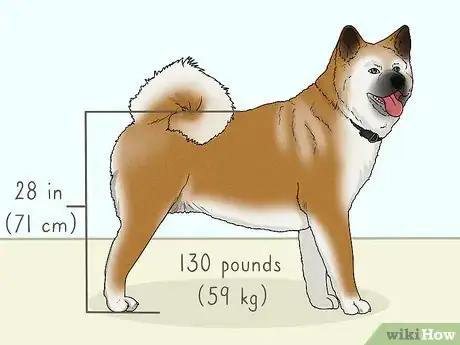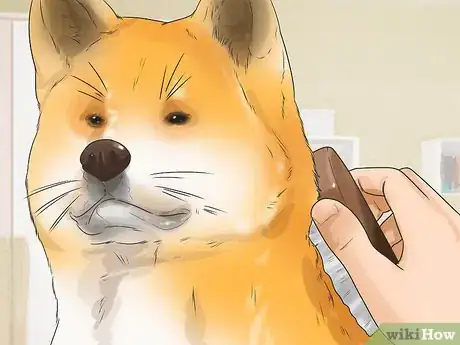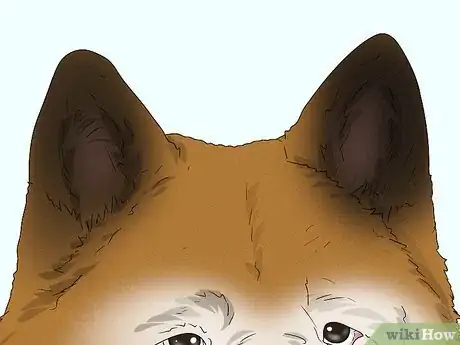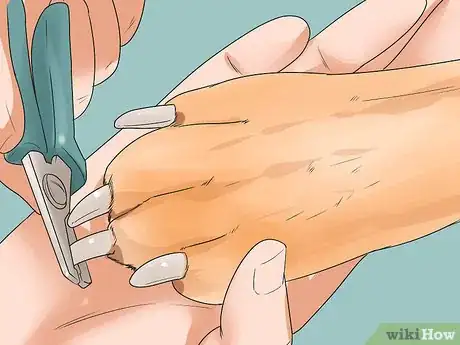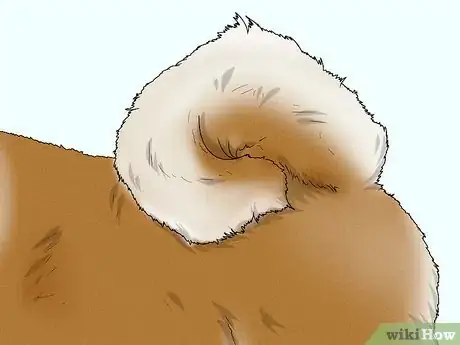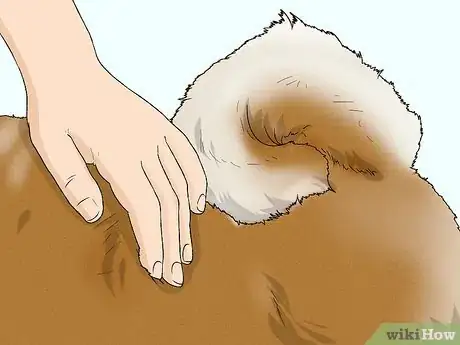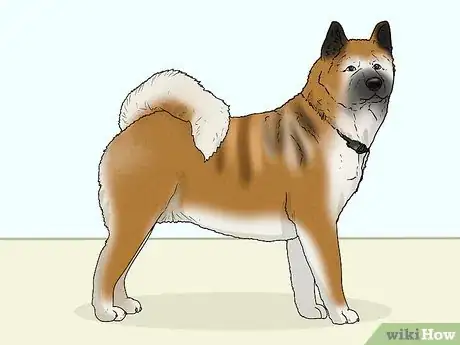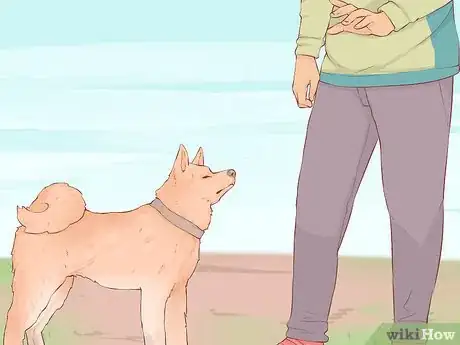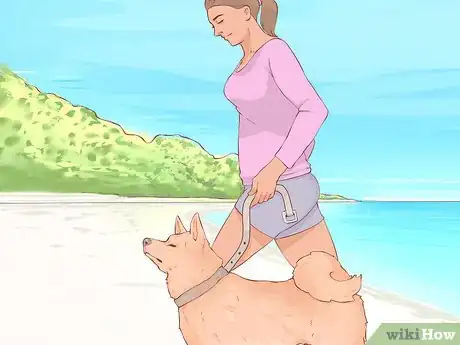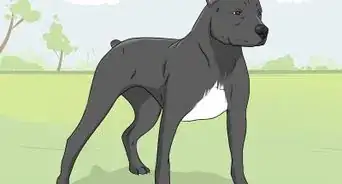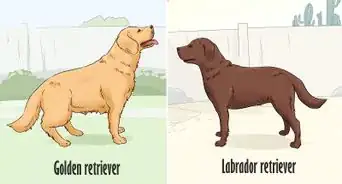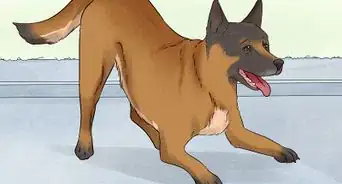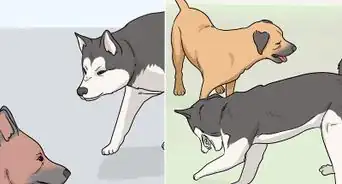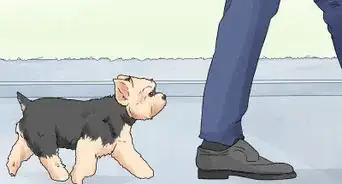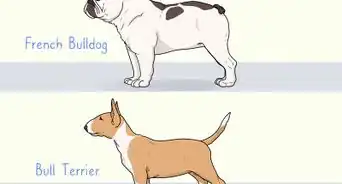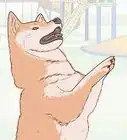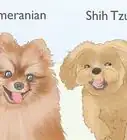wikiHow is a “wiki,” similar to Wikipedia, which means that many of our articles are co-written by multiple authors. To create this article, volunteer authors worked to edit and improve it over time.
This article has been viewed 10,925 times.
Learn more...
The Akita is a large spitz-type breed from Japan that is a member of the working group.[1] Selective breeding brought about the Akita to hunt big game, including deer, boar, and bear.[2] As one of several Japanese spitz breeds, the Akita shares some traits with other breeds. Fortunately, this wikiHow will help you identify the key traits of an Akita.
Viewing the Body Structure
-
1Consider the size of the dog. Akitas are large dogs, standing at 24–28 inches (61–71 cm) in height. They can weigh anywhere from 70 to 130 pounds (32 to 59 kg), with females being on the smaller end and males being on the larger end.[4]
-
2Look at the head. An Akita's head forms a blunt triangle when seen from above and is massive yet flat and broad. The muzzle is broad and full with a level or scissors bite and a broad nose that is typically black but, in white dogs, may be lighter.[5]
-
3Check the eyes. The eyes of an Akita are triangular in shape and small. They are a dark brown color and deep-set with tight black rims.[6]
-
4Examine the ears. Akitas have small, erect ears that are triangular. They are wide at the base, slightly rounded at the tip, set wide but not too low, and carried slightly forward over the eyes and in line with the back of the neck. If the ear is folded forward to be measured, the tip should touch the upper eye rim.[7]
-
5Inspect the paws. The paws of an Akita are "cat feet"-shaped, meaning they are round and neat with high-arched toes.[8] An Akita's paws are well-knuckled with thick pads and face straight ahead. The dewclaws on the hind legs are typically removed.[9]
Did you know? Though an Akita typically has its back dewclaws removed, it generally keeps the dewclaws on its front legs because historically, they served as ice picks to help them climb out of icy water.[10]
-
6Spot the tail. A hallmark of the Akita is the breed's curled tail. An Akita's tail is high-set, large, and full. It is carried over the back or against the flank in a three-quarter, full, or double curl and dips to or below the level of the back. In a three-quarter curled tail, the tip drops well down the flank. The root of the tail is strong and large, and the hair on the tail is coarse, straight, and full, giving no appearance of a plume.[11]
-
7Pay attention to the dog's overall structure. Akitas are large and powerful, with heavy bone and much substance. They have a short but thick neck, wide chest, level back, and straight legs. Akitas walk with a brisk, powerful gait made up of moderately long strides.[12]
Examining the Coat
-
1Analyze the coat's appearance and texture. Akitas have double coats which consist of a thick, dense, soft undercoat and a straight, harsh outer coat that stands somewhat off the body. The fur on the head, ears, and legs is short, while the fur on the withers and rump is approximately 2 inches (5.1 cm) in length and slightly longer than the rest of the body, with the tail being the longest and most profuse part of the coat.[13]
-
2Understand that an Akita may be any color. An Akita may be seen sporting a coat of any color, including white. All colors are brilliant, rich, and clear, and the undercoat may be a different color than the outer coat.[14]
-
3Look for coat patterns. Some Akitas may be a solid color, such as solid white, but coat patterns are also a common occurrence in the breed. Akitas may have brindle or pinto coats or coats with other markings, including a mask or blaze, though white Akitas don't have masks.[15]
- A pinto Akita is seen as a white-coated dog with evenly-placed patches of color covering the head and more than one-third of the body.[16]
Looking at Temperament
-
1
-
2See if the dog is affectionate. Regardless of their independence, Akitas are affectionate dogs. They are known to form strong bonds with their families.[19]
-
3Spot intelligence. The Akita is a highly intelligent breed. This can help during training, but an Akita may also be strong-willed, so they respond best to positive techniques and respectful commands that center around motivation instead of force.[20]
-
4Recognize if the dog is active. As working dogs, it's no surprise that Akitas enjoy activity. They especially enjoy working in the snow, and they may be seen participating in dog sports.[21]
Did you know? Akitas have webbed toes that help distribute their weight when walking on snow.[22]
-
5Look for loyalty. They may be aloof around strangers, but Akitas are profoundly loyal to those they bond with. They are gentle and companionable to their families.[23]
Warnings
- Be aware that Akitas may be banned in certain areas due to their history and overall more primitive personality.[24] Make sure to check the breed bans in your area.⧼thumbs_response⧽
References
- ↑ https://www.akc.org/dog-breeds/akita/
- ↑ https://www.akc.org/dog-breeds/akita/
- ↑ https://www.cuteness.com/blog/content/akitas-vs-akita-inus
- ↑ https://www.akc.org/dog-breeds/akita/
- ↑ https://images.akc.org/pdf/breeds/standards/Akita.pdf
- ↑ https://images.akc.org/pdf/breeds/standards/Akita.pdf
- ↑ https://images.akc.org/pdf/breeds/standards/Akita.pdf
- ↑ https://www.akc.org/about/glossary/
- ↑ https://images.akc.org/pdf/breeds/standards/Akita.pdf
- ↑ https://www.akc.org/expert-advice/lifestyle/akitas-10-facts-that-will-surprise-you/
- ↑ https://images.akc.org/pdf/breeds/standards/Akita.pdf
- ↑ https://images.akc.org/pdf/breeds/standards/Akita.pdf
- ↑ https://images.akc.org/pdf/breeds/standards/Akita.pdf
- ↑ https://images.akc.org/pdf/breeds/standards/Akita.pdf
- ↑ https://images.akc.org/pdf/breeds/standards/Akita.pdf
- ↑ https://images.akc.org/pdf/breeds/standards/Akita.pdf
- ↑ https://www.akc.org/expert-advice/lifestyle/akitas-10-facts-that-will-surprise-you/
- ↑ https://www.akc.org/dog-breeds/akita/
- ↑ https://www.akc.org/expert-advice/lifestyle/akitas-10-facts-that-will-surprise-you/
- ↑ https://www.akc.org/expert-advice/lifestyle/akitas-10-facts-that-will-surprise-you/
- ↑ https://www.akc.org/expert-advice/lifestyle/akitas-10-facts-that-will-surprise-you/
- ↑ https://www.akc.org/expert-advice/lifestyle/akitas-10-facts-that-will-surprise-you/
- ↑ https://www.akc.org/expert-advice/lifestyle/akitas-10-facts-that-will-surprise-you/
- ↑ https://www.yourpurebredpuppy.com/reviews/akitas.html
